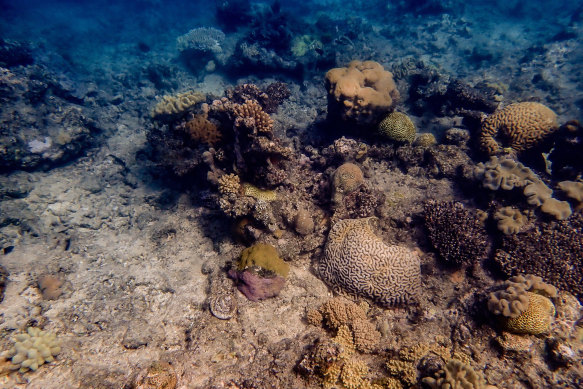This was published 8 months ago
‘Worst fears realised’: One-third of corals dead on section of Barrier Reef
By Mike Foley
One-third of the corals died on a section of the Great Barrier Reef near Cooktown during the past summer’s mass bleaching event, according to the first scientific studies completed since a damaging marine heatwave hit the 2300-kilometre World Heritage listed ecosystem.
Corals don’t necessarily die when they bleach; they switch from their iridescent colourful hues to ghostly white in an indication they are sick and struggling to cope with high temperatures.

Coral bleaching on the northern Great Barrier Reef in September 2024.Credit: AIMS
But the survey results, completed by the Australian Institute of Marine Science (AIMS) over a stretch of reef from Cooktown north to Lizard Island, show a vast amount of the corals have perished.
AIMS is surveying other sections of the reef and experts fear that similar damage could have been wrought on an even wider scale.
“The reefs around Lizard Island or the Northern Great Barrier Reef have lost over a third of the coral cover that was there prior to the summer,” said AIMS survey leader Mike Emslie.
“The heat stress got so high in some areas that mortality is not a surprising outcome. The damage was more substantial on individual reefs in some cases, and in the worst scenario, there was a 72 per cent decline on the pre-summer levels of coral.
“Tropical cyclones Jasper and Kirrily also exposed many to wave heights likely to cause damage to corals, generally greater than four metres.”
AIMS said climate change was driving an increasing rate of coral bleaching. Marine heatwaves drove mass coral bleaching on the reef in 2016, 2017, 2020, 2022 and 2024.
WWF Australia head of Oceans Richard Leck said corals could bounce back from damage but their resilience had limits.
“These initial surveys from AIMS are our worst fears from this year’s coral bleaching event being realised. It can’t get repeatedly hammered like this. We are fast approaching a tipping point.”
The surveys are ongoing and will be conducted on other sections of the reef.
Emslie said surveys are being conducted on the southern section of the reef, which stretches from Gladstone north to Mackay.
“I’ve heard varied stories from different sources about how the southern reefs, some people are saying there’s been really substantial impacts, other people are saying there’s been strong recovery,” he said.
“I will wait for our data before I make any comments.”
Emslie said there is a “feeling of trepidation” that coral death rates on the southern reef could be high, given the marine heatwave hit harder there than in the north.
Bleaching occurs when corals are put under severe stress due to high water temperatures, which causes the organisms to expel the algae living in their tissues and turn white.
Bleaching can kill corals, but not all that turn white die. They can recover if sea surface temperatures return to normal quickly enough.
Record temperatures were set during this year’s bleaching, with the mean sea surface temperature in 2024 more than 0.19 degrees above the previous record set in 2017.
Get to the heart of what’s happening with climate change and the environment. Sign up for our fortnightly Environment newsletter.